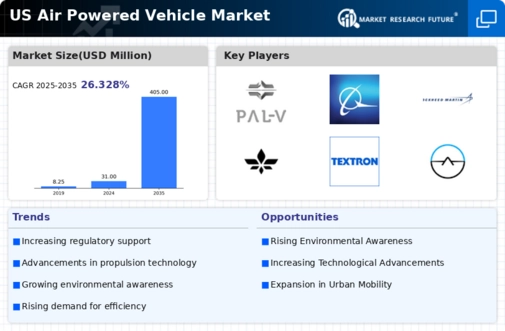Rising Fuel Costs
The air powered-vehicle market is likely to gain traction as rising fuel costs continue to burden consumers and businesses. With fluctuating oil prices and increasing demand for energy, the cost of gasoline and diesel has become a significant concern. This economic pressure may lead consumers to explore alternative transportation options, such as air powered vehicles, which promise lower operational costs. The air powered-vehicle market could see a notable increase in adoption rates as individuals and companies seek to mitigate fuel expenses. According to recent data, the average price of gasoline in the US has risen by approximately 30% over the past year, prompting a shift in consumer behavior towards more cost-effective and sustainable transportation solutions.
Environmental Sustainability Initiatives
The air powered-vehicle market is experiencing a surge in interest due to increasing environmental sustainability initiatives. As concerns about climate change intensify, consumers and businesses alike are seeking cleaner alternatives to traditional fossil fuel-powered vehicles. The air powered-vehicle market aligns with these initiatives by offering a zero-emission transportation solution. In the US, various states have implemented policies aimed at reducing greenhouse gas emissions, which could potentially drive demand for air powered vehicles. For instance, California's ambitious goals to achieve carbon neutrality by 2045 may encourage investments in this market. Furthermore, the air powered-vehicle market is likely to benefit from federal incentives aimed at promoting sustainable technologies, thereby enhancing its growth prospects.
Growing Urbanization and Traffic Congestion
The growing trend of urbanization and increasing traffic congestion in major US cities is likely to drive interest in the air powered-vehicle market. As urban populations expand, the demand for efficient and compact transportation solutions becomes more pressing. Air powered vehicles, with their potential for reduced space requirements and lower emissions, may appeal to city dwellers seeking alternatives to conventional vehicles. The air powered-vehicle market could see a rise in demand as municipalities explore innovative solutions to combat traffic congestion and improve air quality. Furthermore, urban planning initiatives that prioritize sustainable transportation options may further enhance the attractiveness of air powered vehicles in densely populated areas.
Technological Innovations in Air Compression
Technological innovations in air compression systems are playing a pivotal role in shaping the air powered-vehicle market. Advances in materials science and engineering have led to the development of more efficient and lightweight air storage systems, enhancing vehicle performance. The air powered-vehicle market is witnessing the introduction of cutting-edge technologies that improve energy efficiency and reduce production costs. For instance, the integration of advanced composite materials in air tanks can significantly increase their durability and reduce weight, thereby improving vehicle range. As these innovations continue to evolve, they may attract investments and partnerships, further propelling the growth of the air powered-vehicle market.
Government Incentives for Clean Transportation
Government incentives aimed at promoting clean transportation are likely to bolster the air powered-vehicle market. Federal and state programs designed to encourage the adoption of environmentally friendly vehicles can provide financial support to manufacturers and consumers alike. Tax credits, rebates, and grants for purchasing air powered vehicles may stimulate demand and enhance market penetration. The air powered-vehicle market stands to benefit from these initiatives, as they can lower the overall cost of ownership for consumers. Recent legislative efforts in the US have proposed increased funding for clean vehicle programs, which could potentially lead to a more favorable regulatory environment for the air powered-vehicle market.

















Leave a Comment